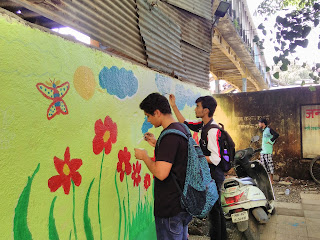 |
| BMC school students at Santacruz East station with CACR |
Art is something that brings a smile on my face and a
pleasant sigh making me feel “Today is going to be a great day!” So, imagine my
happiness when every step I took at the railway station I found a painting;
especially when a Van Gogh’s “Starry Nights” played right in to my vision. I
was standing there for a few minutes just looking at it, giddy with happiness
hoping to stop everyone and say “This is a Van Gogh, even though it is not the
original.”
As kids, we loved doodling; on our walls and in our notebook.
Unfortunately the wall thing was banned both by school and parents as it was a
risk to their sanity. But giving it an outlet through decorating your railway
station is an exciting idea. It kills two birds with one stone; one’s fantasy
of painting on walls, with the added benefit of beautifying one’s stations.
Mumbai First and Making
A Difference (M.A.D) initiative in collaboration with the Western
and Central Railways came up with the Beautification programme, called ‘Hamara Station Hamari Shaan’ as part
of a Nationwide voluntary initiative called Daan
Utsav, executed from 2nd to 8th October 2016.
Citizen Association for Child
Rights (CACR) decided to take this opportunity to the MCGM Children too,
giving them a chance to explore the world of art and be a part of the Clean
India movement. Not only did they get a chance to see their works on the wall
being viewed by millions, but they also got chance to be meet other artists and
support PM Narendra Modi’s Swachh Bharat dream.
CACR members Vidya Vaidya and Ar
Deyasini Choudhury supervised the entire project. MCGM school students from
both western and central side participated in this program for a day each. There are 21
stations in western suburb and 15 stations in central suburb. A total of 164
BMC school students from seven schools helped in coloring six railway stations
(two in central suburb and four in western suburbs).
In order to understand this program,
I went to Santacruz East Station on 8th October, where Ar Deyasini
Choudhary and Vinita Menon of CACR and Viren Shah of MAD were coordinating the
project. A total of 60 MCGM school students from Juhu and Andheri were ready to
give the walls of the station ticket counter area a much needed makeover. They
all were eagerly awaiting instructions with paint brushes in one hand and paint
in other. While some were painting the trains, others were painting flowers,
butterflies, leaves and grass.
 |
| At Mulund |
 |
| At Vile Parle |
 |
| At Bandra |
A few students from NMIMS Mukesh
Patel School of Technology – Vidhi Shethi, Daanish Gandhi and Vinay had also
volunteered their help. Our graduates and under graduates have realised that to
make a change, we have to be a part of the change and participate in such
programs, stating “Where there is a will there is a way”.
 |
| CACR volunteers from NMIMS-MPET |
Along the way I also met Allwyn
Pereira, the R N Podar School Art Teacher with some of his student volunteers
painting on the walls of the foot over bridges(FOB). It is great to have
teachers going beyond the four walls and supporting such initiatives.
I also met the artist of Van Gogh’s
‘Starry Night’, Snehal Patil (an independent artist) who had beautified the
outer walls of Station Master’s cabin, the Ticket Window and the FOBs.
Art is really underappreciated in our
country, in spite of our vibrant cultural history and our living arts. So
through this program, we are providing a medium to both art and artist to
showcase their potential to the world, especially in a locale where the
commuter otherwise would not have the time to go beyond his/her daily routine
to view art.
Also, art plays a very big role in a
city’s holistic development. A “smart city” that we talk about so much should
have both art and technology going hand in hand.
It is also important for children to participate in such
initiatives from an early age to respect public spaces, to understand the concept
of ‘giving back’- especially for MCGM School children, who have very few
avenues of participating in such events, giving them a sense of belonging and
help inculcate in them a sound civic sense, of responsibility, and the most
important the joy of creating beauty!
 |
From tomorrow onwards, the people of
Mumbai will have something exciting and interesting to see on the platforms,
FOBs and ticket windows daily, rather than the dark and dirty drudgery they are
accustomed to.
It just depends on how many are
willing to pause for a second and appreciate these efforts.
Visit www.ngocacr.com to know more.
Visit www.ngocacr.com to know more.












